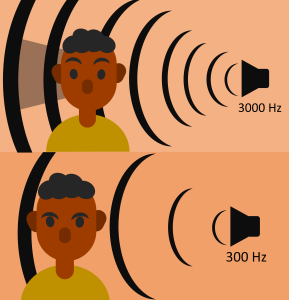Hearing in Complex Environments
73
Learning Objectives
Know that interaural level difference (ILD) is a binaural cue.
Be able to explain why ILD is useful for high-frequency sounds only (frequency-dependent).
Understand the difference between ILD (higher frequency) and ITD (below about 1500 Hz).
If a sound comes from an off-center location, it creates two types of binaural cues: interaural level differences and interaural timing differences. Interaural level difference refers to the fact that a sound coming from the right side of your body is more intense at your right ear than at your left ear, and vice versa for sounds from the left, because of the attenuation of the sound wave as it passes through your head.

Interaural level difference (ILD) is a binaural cue for high-frequency sounds only. High frequency sounds have short wavelengths, so the head casts an acoustic shadow and sounds are quieter in the ear away from the sound. Below about 1000 Hz, there is no ILD because the head is small compared to the wavelength of the air pressure perturbation. The sound sweeps on by without really noticing the head. ILDs can be as big as 20dB for some frequencies; they depend both on frequency and on the direction that sounds are coming from. ILDs are more useful at higher frequencies; ITDs stop being useful at about 1500 Hz.
Interaural level difference refers to the fact that a sound coming from the right side of your body is more intense at your right ear than at your left ear because of the attenuation of the sound wave as it passes through your head. Interaural timing difference refers to the small difference in the time at which a given sound wave arrives at each ear. Certain brain areas monitor these differences to construct where along a horizontal axis a sound originates.
CC LICENSED CONTENT, SHARED PREVIOUSLY
OpenStax, Psychology Chapter 5.4 Hearing
Provided by: Rice University.
Download for free at http://cnx.org/contents/4abf04bf-93a0-45c3-9cbc-2cefd46e68cc@5.103.
License: CC-BY 4.0
Cheryl Olman PSY 3031 Detailed Outline
Provided by: University of Minnesota
Download for free at http://vision.psych.umn.edu/users/caolman/courses/PSY3031/
License of original source: CC Attribution 4.0
Adapted by: Chandni Jaspal

